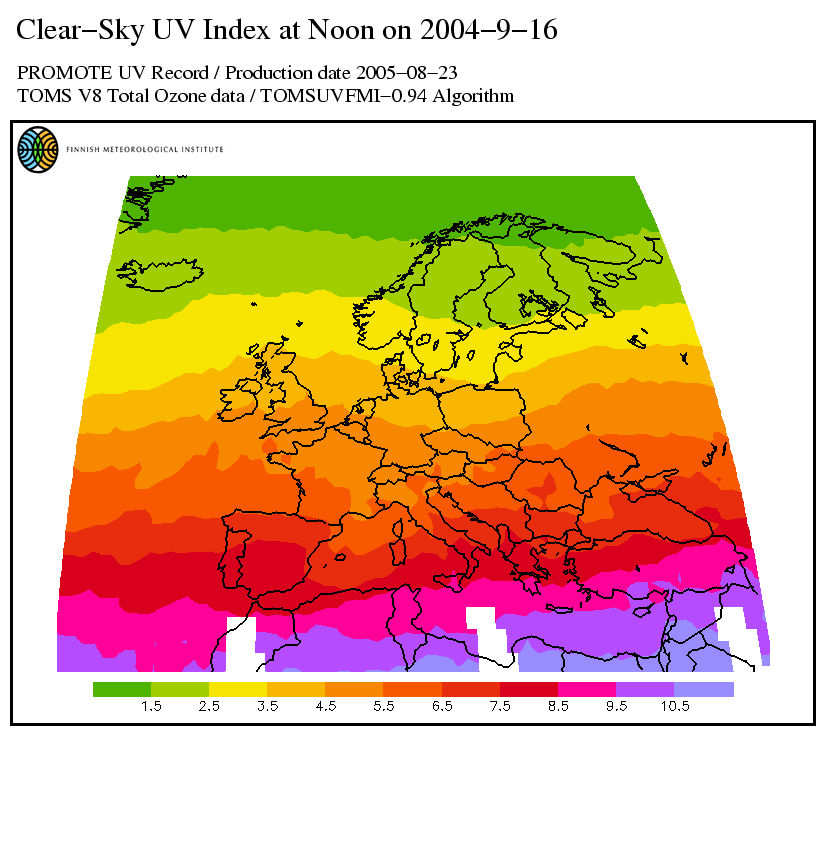UV Dose and Index Record from Nimbus-7/Earth Probe TOMS

UV Dose and Index Record from Nimbus-7/Earth Probe TOMS
|
 |
The intensity of the solar ultraviolet (UV) radiation is an important environmental factor that affects human health, troposheric photochemistry, terrestrial and aquatic ecosystems as well as materials. It is closely related to the atmospheric composition because the amount of the total ozone directly affects the amount of the UV radiation on the Earth's surface. These archives contain maps and local timeseries of the past clear sky UV index at noon and the cloud corrected daily erythemal dose. The surface UV data are based on the measurements of the NASA Total Ozone Mapping Spectrometer (TOMS) onboard the Nimbus-7 and Earth Probe satellites.
 |
| Global and European Maps of UV Index and Daily Dose: | November 1978 - September 2004 |
| Local Timeseries of UV Index and Daily Dose : | July 1996 - June 2004 |
The estimates of UV index and daily dose were otained using the version 8 of the Level 2 TOMS total ozone data and the TOMSUVFMI 0.94 algorithm. More information about the TOMS instruments and the TOMS data products can be found at the NASA/GSFC website. It is based on radiative transfer model whose input parameters are derived from TOMS data. The clear-sky UV index is obtained using total column ozone and additional geophysical data. Estimation of daily dose requires modelling of attenuation of UV radiation by clouds. TOMSUVFMI first determines the optical thickness of cloud from calculated TOMS planetary albedo, and the attenuation of UV radiation by the cloud is obtained by another model. The surface albedo is obtained from a new surface albedo climatology. The algorithm can account for absorbing aerosols in the clear-sky case. The TOMSUVFMI algorithm is intended to be applied to Aura/OMI data. There are also plans to estimate UV doses for other than erythemal effects (different action spectra), doses on tilted surfaces or the actinic flux, and underwater doses.
The erythemal daily doses of UV Record were compared with Brewer measurement data of Jokioinen.
UV Index is a measure of the human skin relevant intensity of UV radiation on the Earth's surface. UV Index is a unitless quantity that is linearly related to th erythemally weighted dose rate (1 UV Index equals 25 mW per square meter). UV Index varies throughout the day due to the solar elevation and cloud attenuation. The clear-sky UV Index of the UV Record service is an estimate of the local solar noon UV Index assuming cloud free conditions. Thus, the clear-sky UV Index usually overestimates the actual intensity of the UV radiation reaching the Earth's surface. However, it is a useful measure for informing general public of the potential harmful effects of UV radiation.
Daily dose is the diurnally integrated amount of UV radiation on the Earth's surface. The daily dose of the UV Record service, that is given in kJ per squre meter units, is an estimate of the erythemally weighted daily dose taking into account the attenuating effect of clouds. Additionally, the estimate is corrected for strongly absorbing aerosols in the clear-sky case.
The TOMS data are courtesy of NASA and the surface UV algorithm
inherits from the TOMS UV algorithm developed by NASA/GSFC.
Aapo Tanskanen, last modified: September 2005